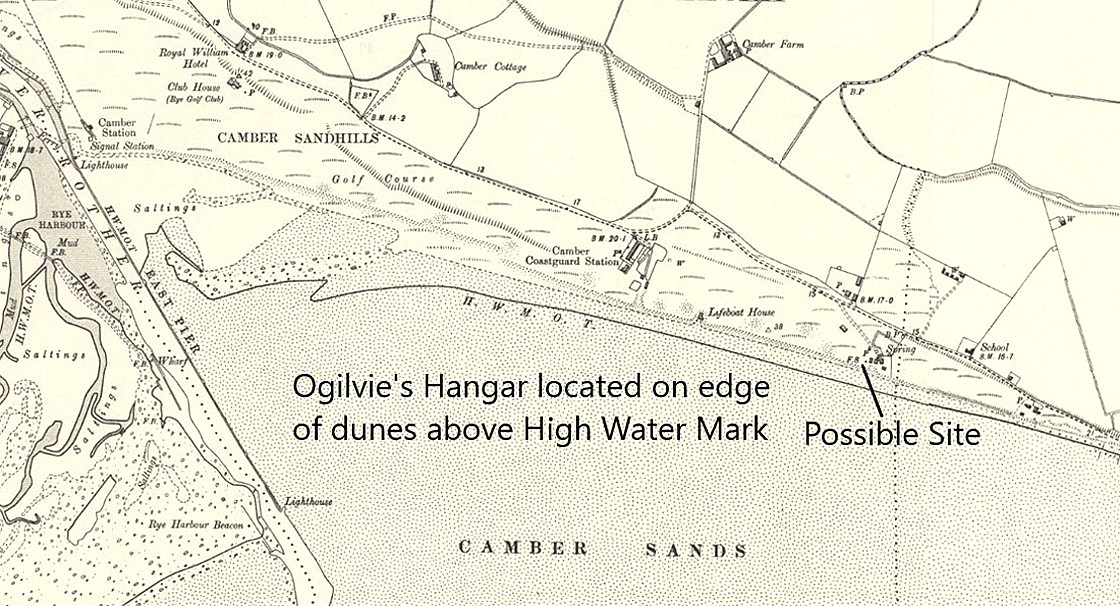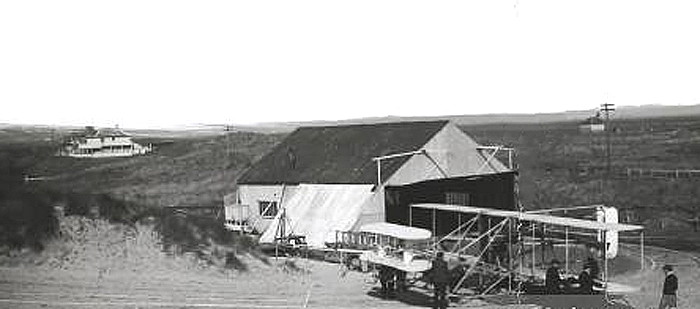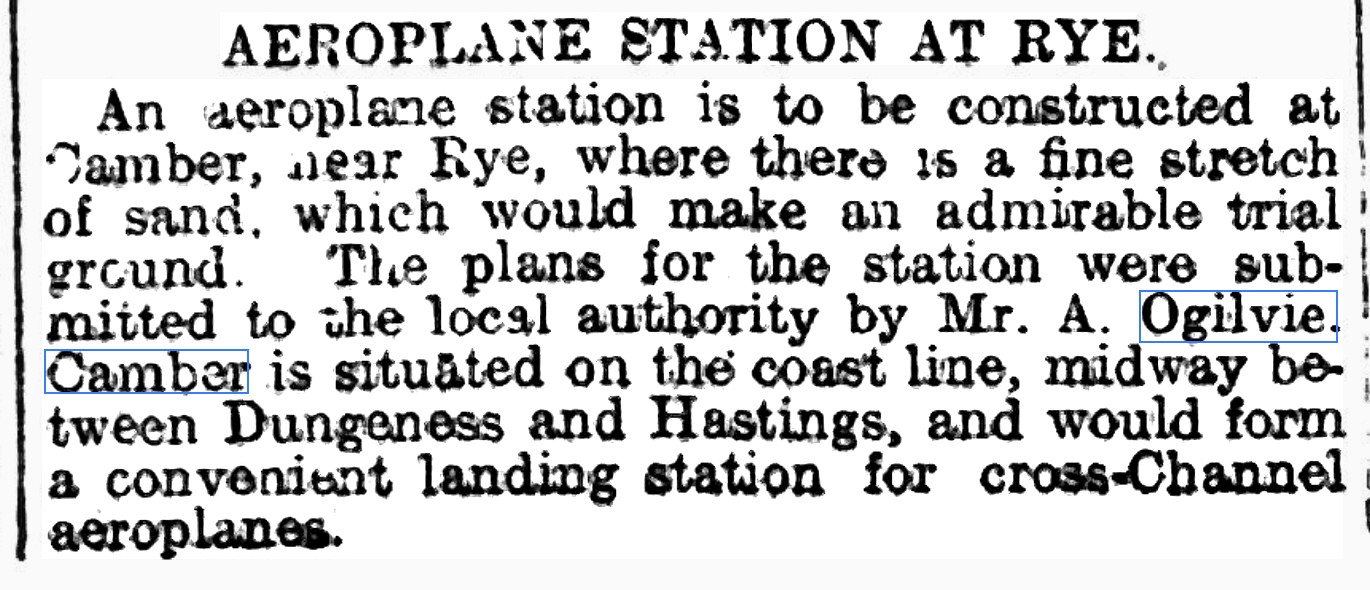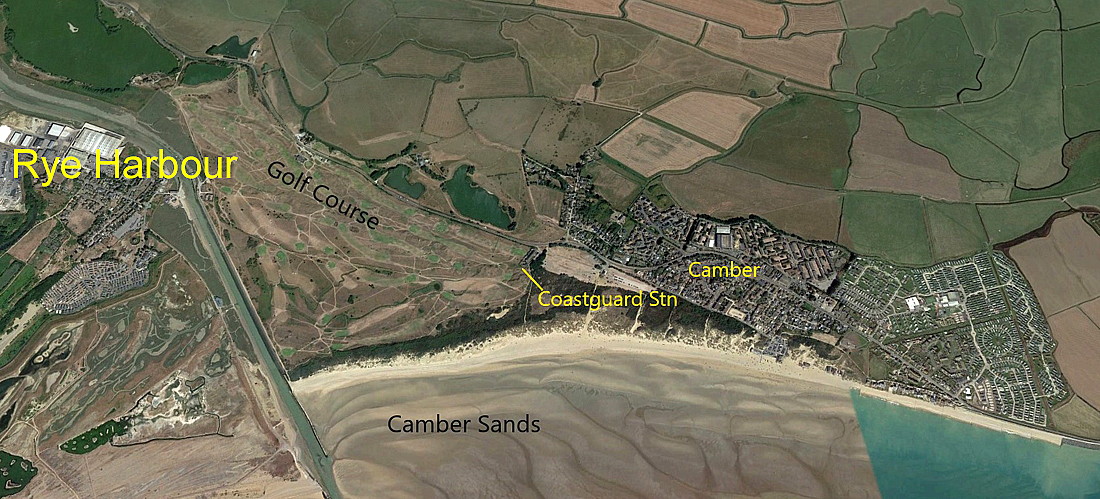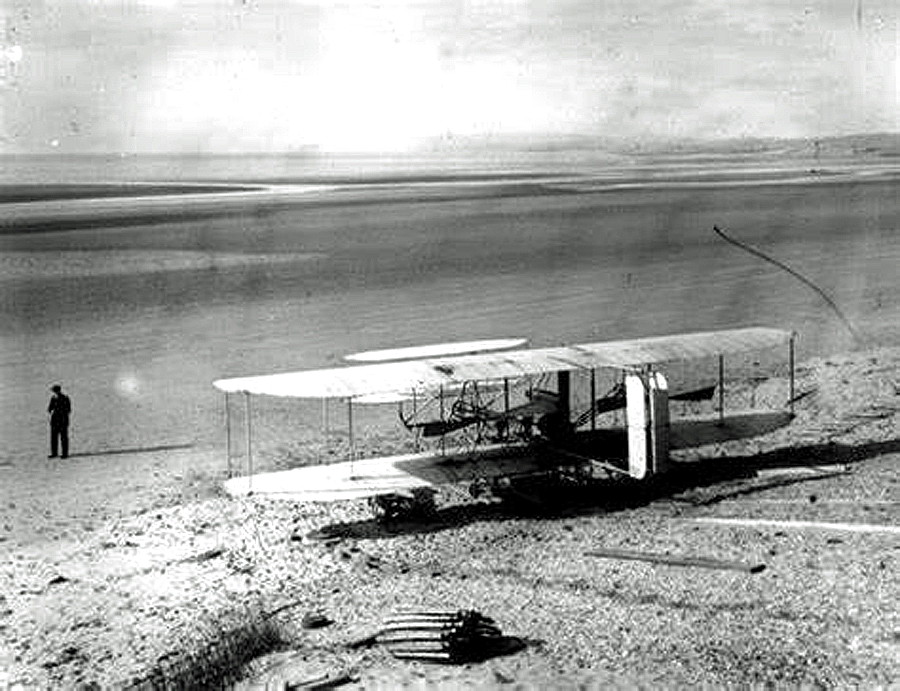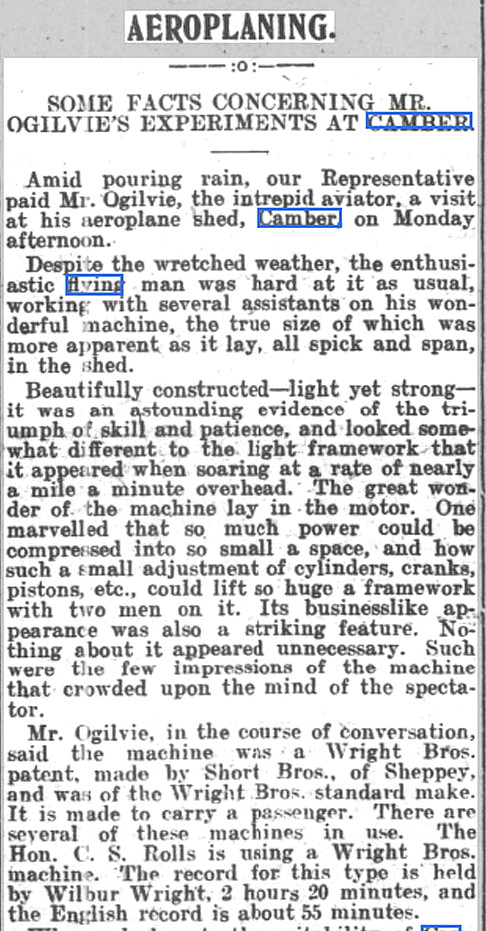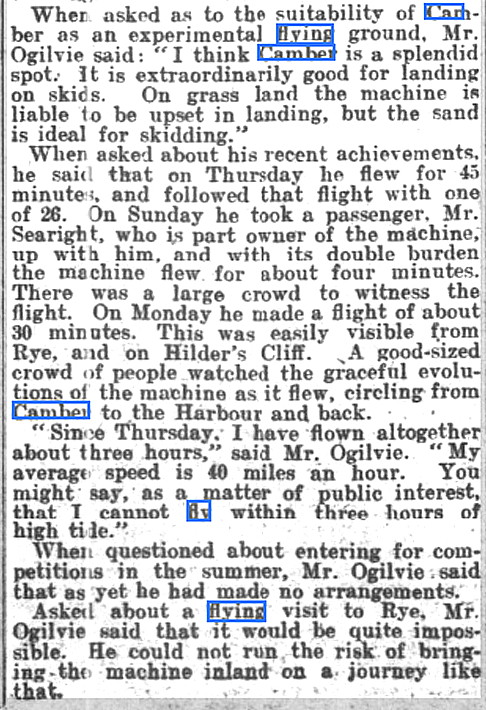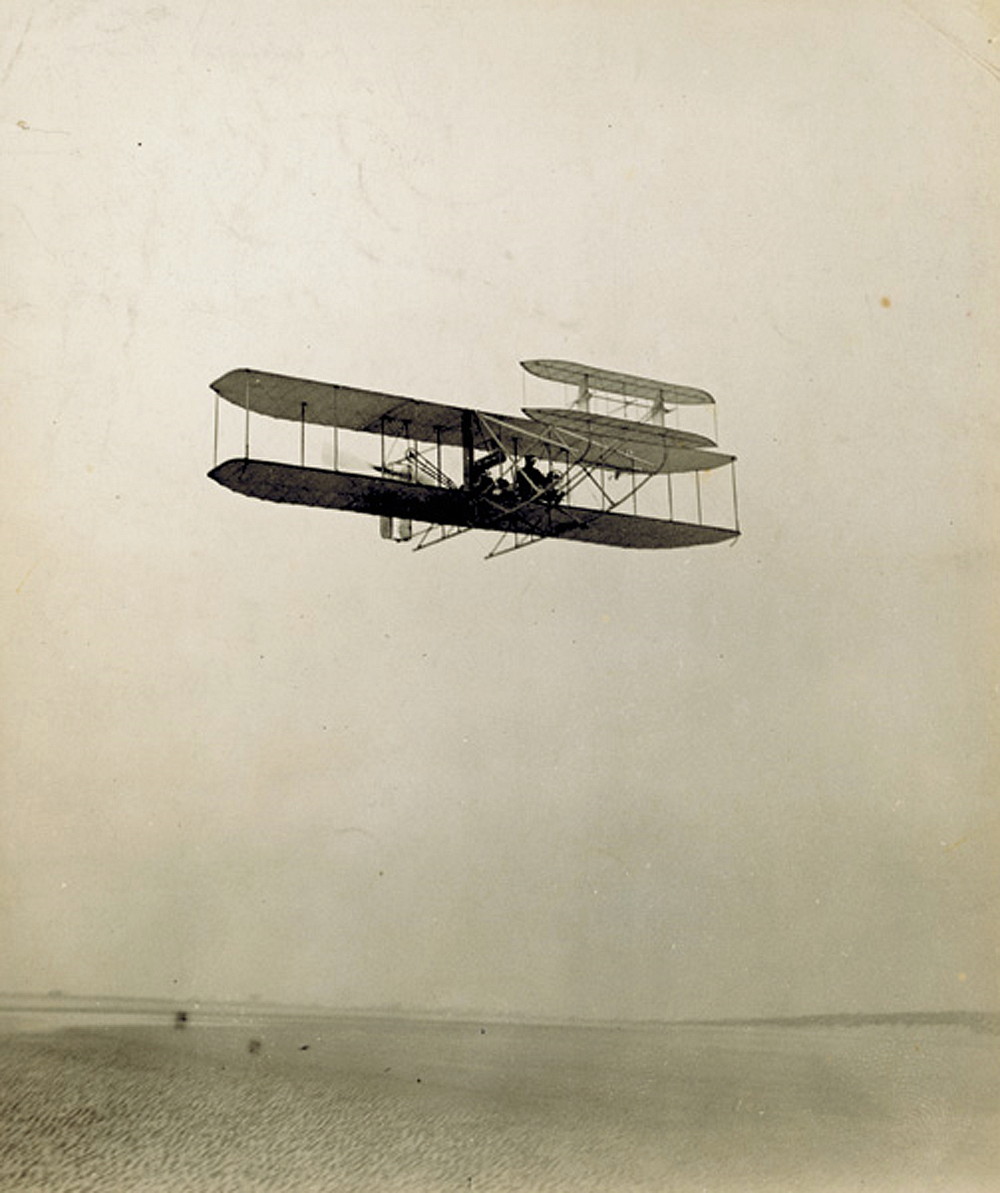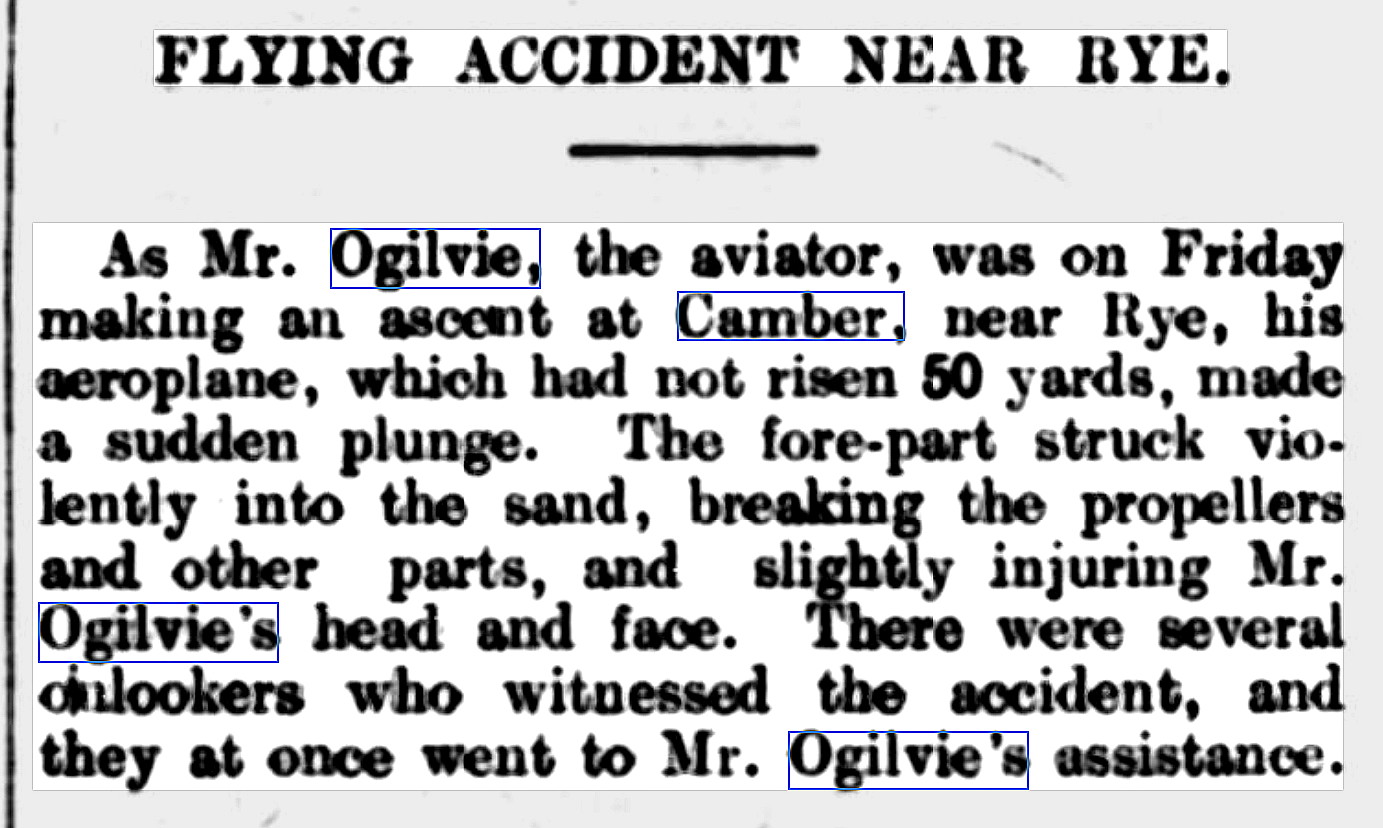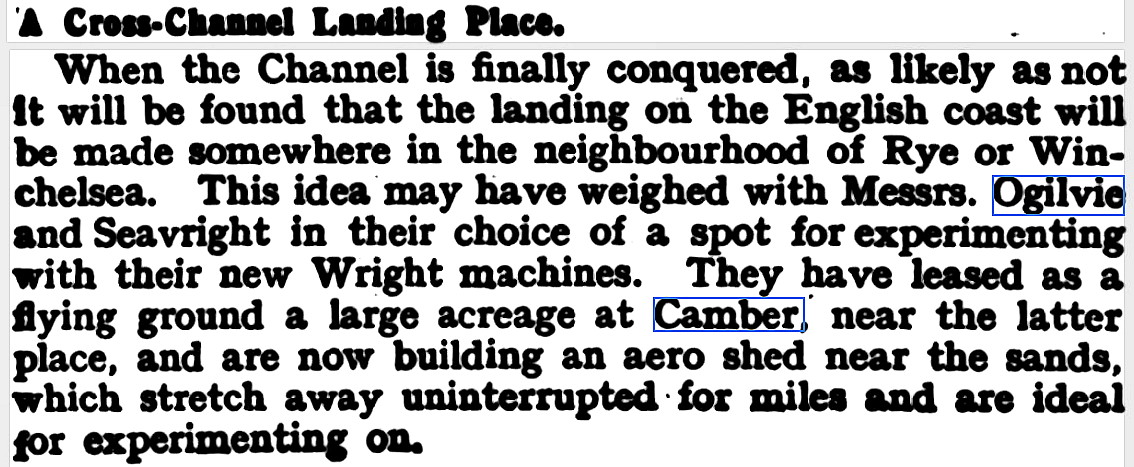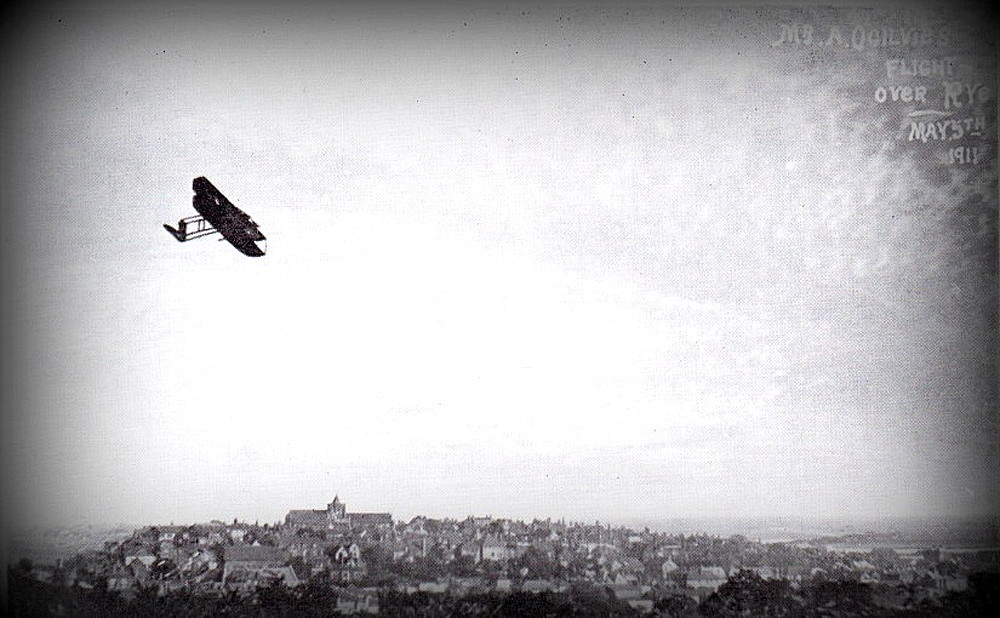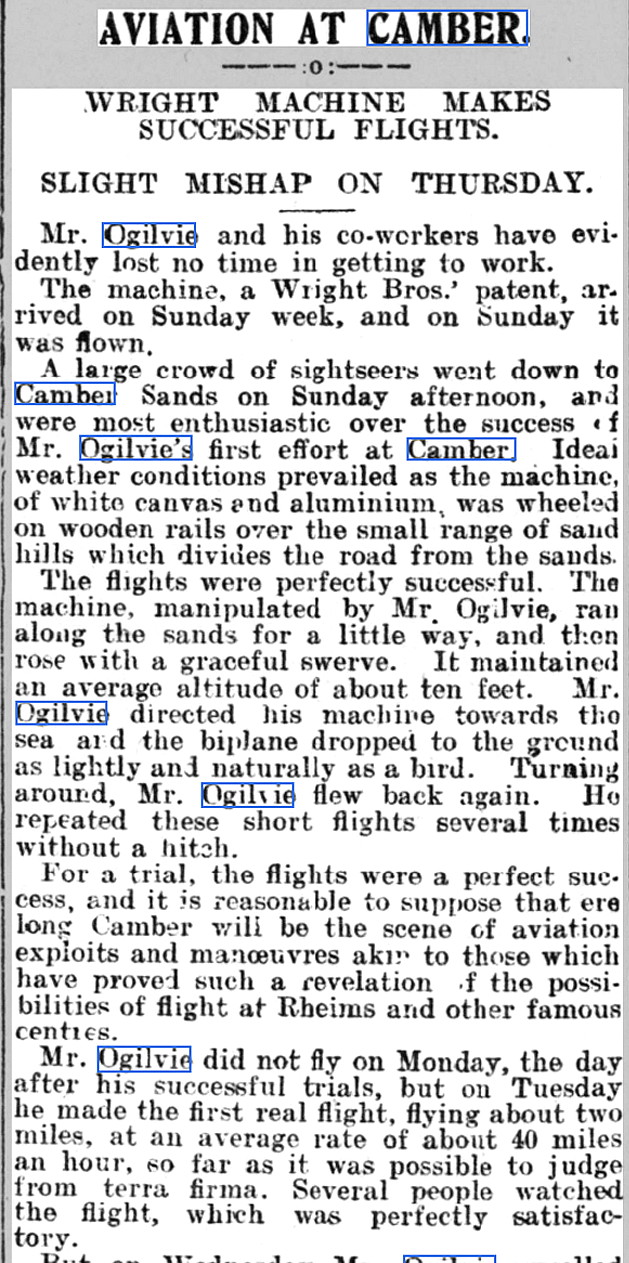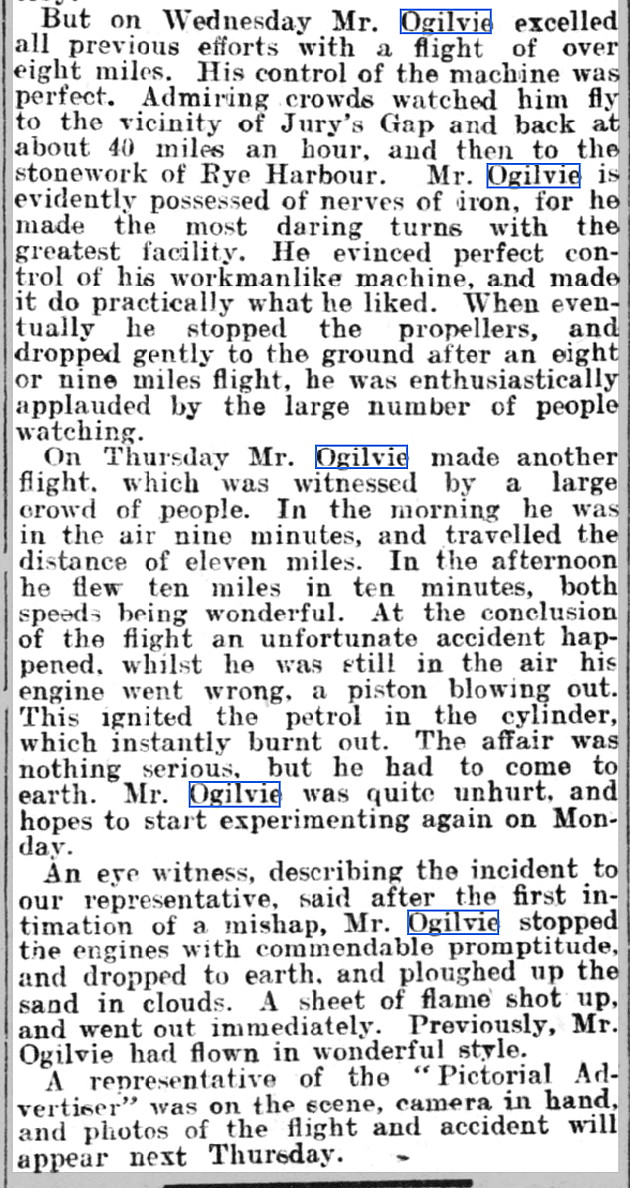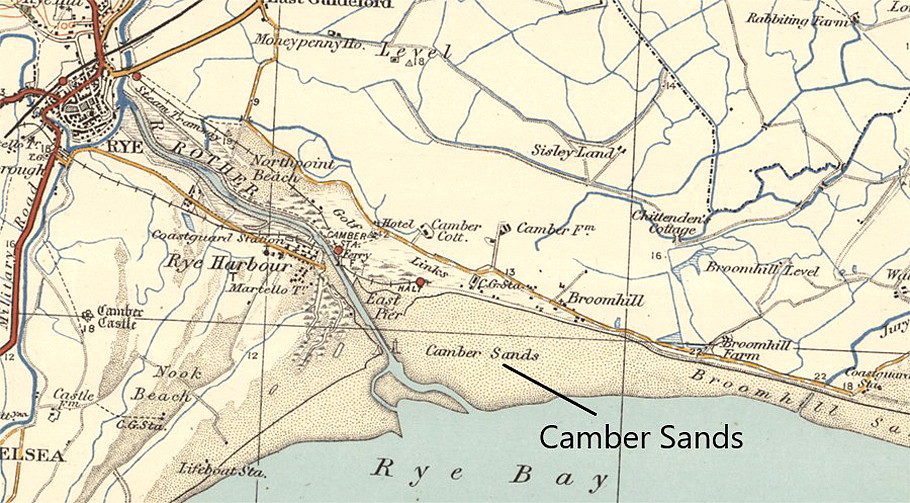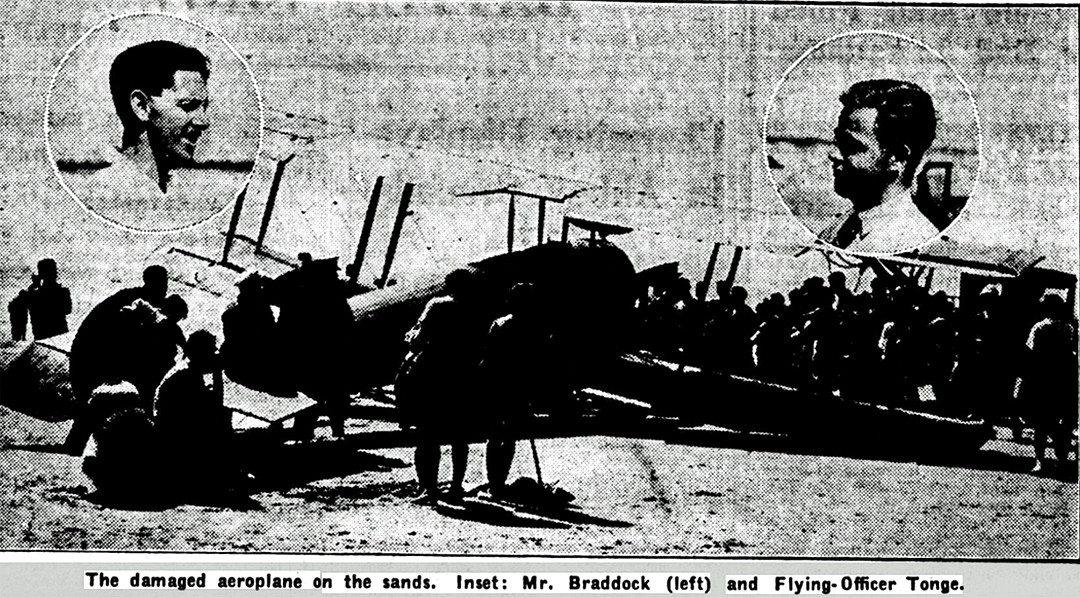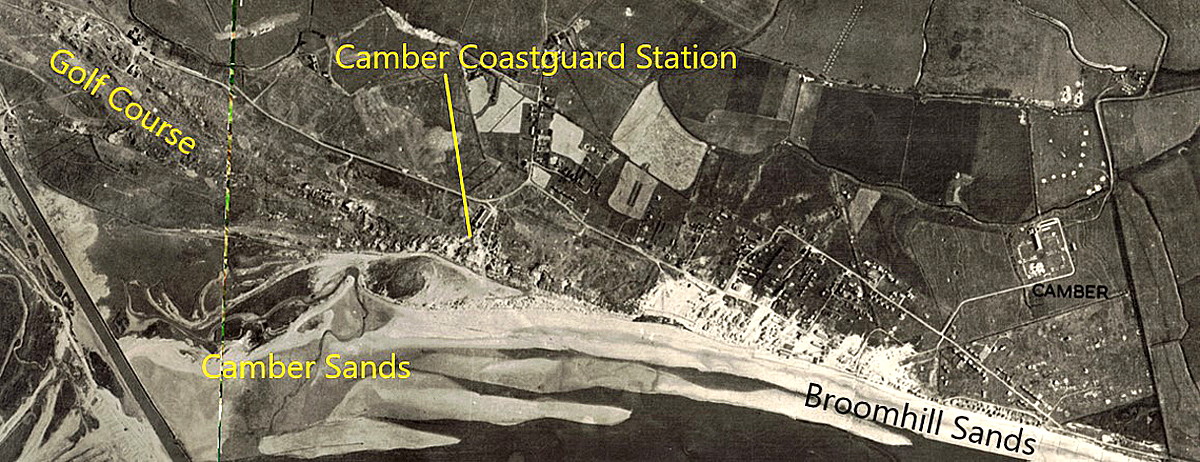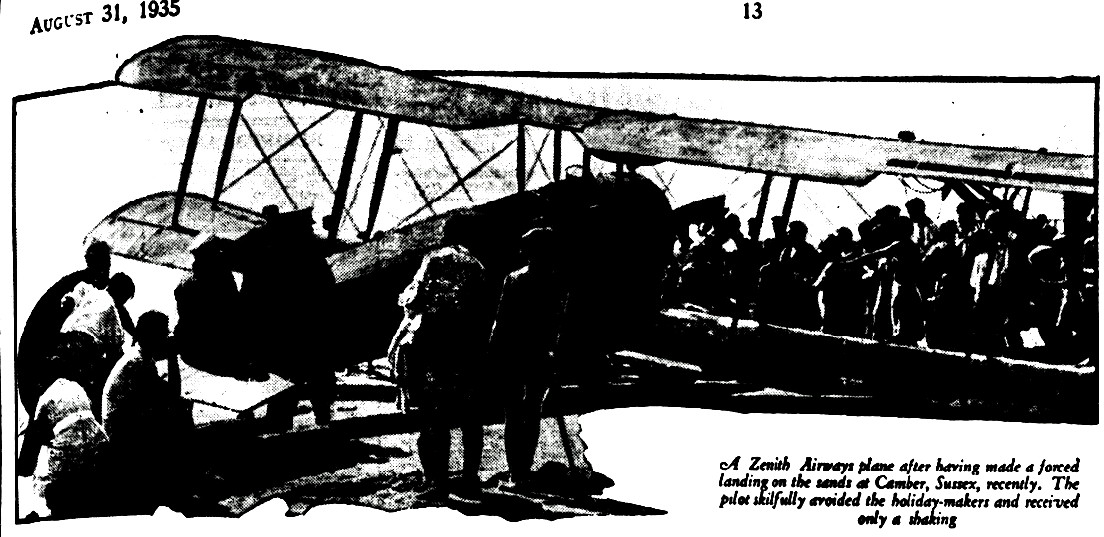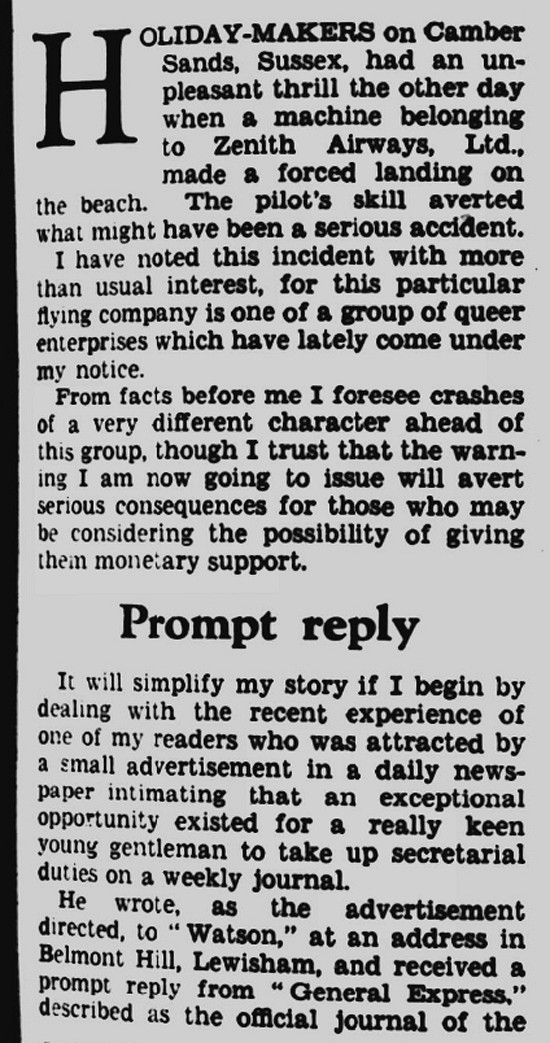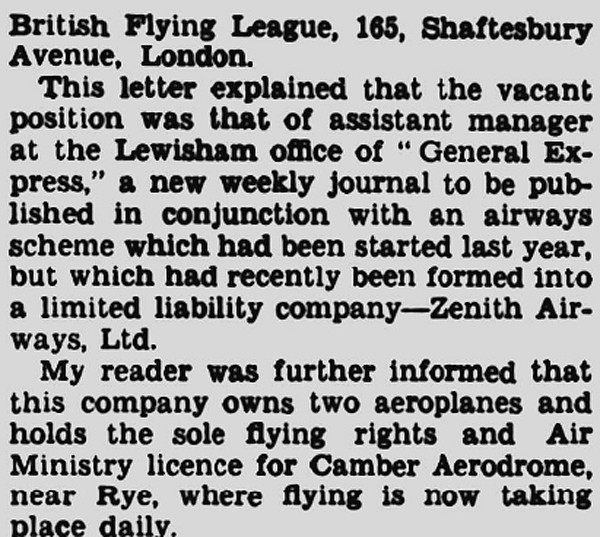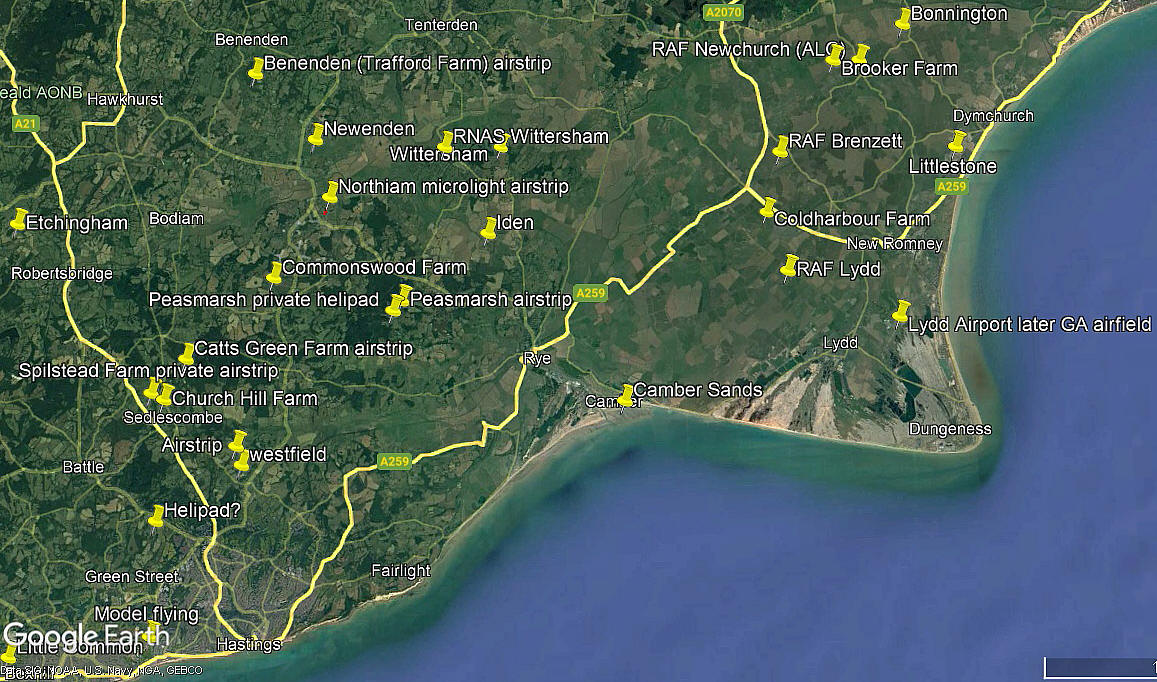Camber
CAMBER: One of the first UK private flying grounds or ‘aerodrome’
(Also known as CAMBER SANDS)
Operated by: Mr Alec Ogilvie
Location: Roughly 2.5nm SE of Rye
Period of operation: 1909 to 1911
Flying area: At least two miles by about half a mile (Over the sands)
NOTES: According to official, (Royal Aero Club?), records Mr Ogilvie was awarded No.7 pilots certificate probably for flying a Short-Wright No.2 Biplane on the 24th of May 1910? Other sources state May 15th 1911? He started learning to fly, mostly teaching himself it seems, with a No.2 type, with the inevitable crash on the 17th December 1909. He later flew modified versions of the No.2 type from here so there is some doubt as to exact type he used on the day to pass his test. I’m guessing but think it quite possible his flying test was actually performed at EASTCHURCH on a similar type?
I had compiled the above and thought it probably accurate until reading Ron Smith’s British Built Aircraft Vol 3 in which he in turn quotes from British Built Aircraft Before The Great War by Michael H Goodall and Albert E Tagg. They say that initially Ogilvie was flying the Aerial Manufacturing Co. monoplane in late 1909 for distances up to 250 yards. (My note: These would almost certainly be ‘straights’ or ‘hops’ with no deliberate turns involved). The machine was of unconventional design, with a number of auxiliary aerofoils associated with an articulating undercarriage. But, not from CAMBER.
So, the Short-Wright No.2 was Ogilvie’s second aircraft. “Alec Ogilvie had a private flying ground at Camber Sands, which he used for flying and developing his Short-Wright (No.2) biplane, which was delivered at the beginning of September 1909. By November 1910 flights of more than ten minutes’ duration were being made.” This episode illustrates very well the often painfully slow rate of progress in those very early days of aviation in the UK. But, once they got the hang of it the rate of progress developed very quickly indeed.
As Ron Smith points out; “Ogilvie also took ownership of the No.6 Short-Wright following the death of C.S. Rolls….” (My note: This accident occurred during the first Bournemouth ‘International Aviation Meeting’ on the 11th July 1910. [See entry for SOUTHBOURNE]. C S Rolls was the ‘Rolls’ in Rolls-Royce which in those days was making a mark in producing cars of exceptional quality, and his other claim to fame is being the first British person/pilot to die in a flying accident. “…flying this at Camber in October 1910. Ogilvie modified this machine, turning it into one of the most successful of its type, the changes made including the removal of the front elevator.
In December 1910 this aircraft was flown 142 miles in less than four hours. This much-modified aircraft continued flying right up to the outbreak of the First World War. Ogilvie’s lease of Camber Sands expired in May 1911, after which he returned to Eastchurch.” (This is EASTCHURCH – KENT of course).
It would appear that this EASTCHURCH site can make a claim to be the ‘grandfather’ of British private Landing Grounds? Albeit it was more an aerodrome site. As mentioned elsewhere an aerodrome in the early days was a large area within which flying took place, aircraft in flight rarely flying much beyond the boundaries. Therefore hard to envisage today the massive impact when a few pioneers set out to fly point to point over considerable distances. Such as the London to Manchester Air Race in April 1910.
In British Built Aircraft Vol.3 Ron Smith also says; “….the unsuccessful 1908 Howard-Wright biplane was tested at Fambridge, (see ESSEX), before further attempts to fly at Camber Sands.” So, did Ogilvie and Howard-Wright share facilities? Later Howard-Wright moved to BROOKLANDS in SURREY. He adds; “A contemporary description of the Camber Sands flying area was as follows: ‘At low tide, moderately hard sand and soft places. Area about two miles by one mile.’
A MICHAEL T HOLDER GALLERY (FIRST PART)
This compilation from Mike Holder, a great friend of this 'Guide', adds a great deal more information to this story.
Note: The Photo No.1 shows the Short-Wright No.2 outside of its hangar. Date unknown? The short article was published in the Globe on the 11th March 1909.
Note: Photo No.2 shows the Short-Wright No.2 on the shoreline, and was published in Rye's Own Magazine on the 29th March 1910. The article in two parts was published in the Hastings and St Leonards Observer on the 12th March 1909. Photo No.3 shows Mr Ogilvie flying his Short-Wright No.2 from CAMBER on the 22nd April 1910.
THREE SHORT ARTICLES
The flying activities of Mr Ogilvie certainly gained a lot of attention in the press at that time.
The short article No.1 was published in the Daily News (London) on the 13th November 1909.
The No.2 article was published in the Halifax Evening Courier on the 3rd December 1909, and the No.3 article appeared in the Christmas Day edition of the Sheerness Times Guardian on the..... you've guessed it of course, the 25th of December, also in 1909.
The short article above was published in John Bull on the 19th June 1909. Well worth a read to see their predictions at that same, when just over a month later Blériot flew across the Channel and crash landed at Dover! The article in two parts was published in the Hastings and St Leonards Observer on the 13th November 1909.
The photo was published in Rye's Own Magazine on the 5th May 1911. It looks to me to be based on a Wright Flyer type, which Short Brothers were making, but, with no forward mounted elevators. Instead appearing to have them mounted at the rear. I can find no corresponding type produced by Short Brothers? By that time it was realised that, as a general principal, having the elevators behind the mainplane(s) was a better solution, but this version looks to me to be rather short-coupled, and therefore still sensitive in pitch. The town in the background is Rye.
FURTHER NOTES
If you find early aviation history fascinating, (a subject that came to me rather late in life), and if you can find a copy of it, (at least one example is available from the library system), I would recommend reading page 86 of C C Turners Old Flying Days to find out more about this site.
This said, I think it well worth recounting in full a later account in this fine book about the costs of flying in those early days. C C Turner wrote these remarks in late 1911, and I quote:
“The price of a machine, including the motor, may be anything from £400 to £1,200; and there is no longer any reason to look askance at the lower end of the scale. Unless a purchaser desire an aeroplane that will travel at a speed of over 60 m.p.h., with two up, he need not anticipate an initial outlay of more than £600 or £700; he can even do it on less. The cost of learning to fly, including insurance, is £75 at most of the schools.”
“The price of a shed at Brooklands, which may be taken as a fair average ground, is £100 per annum. It is possible to economise in this respect. Mr. Cockburn possesses his own shed on Salisbury Plain, and pays, I believe, a small ground rent. Mr. Olgivie for a long time had a shed on the sands at Camber, near Rye.”
“The private owner of an aeroplane must have the services of a good mechanic, and he should also employ a boy. The combined wages of these servants will be £170 or £180 a year. The cost of flying as regards fuel and oil is easily reckoned. In the case of the most extravagant engine of 50 h.p. the consumption, perhaps, amounts to about 13s. per hour. Less extravagant and lower-powered engines mean economy.”
“Accidents will happen even to skilful flyers, and bad landings are a thing to be reckoned with. These should be provided for in advance by a fund for the purpose; it is, indeed, already possible to insure against them. The principal thing to bear in mind at the moment is that the damage done to aeroplanes even in bad smashes costs comparatively little to repair. It is very uncommon for a smash to exceed £20. Most mishaps involve the flyer in no greater expense than a sovereign or two, the reason being that the motor, which is the most expensive part of the machine, is rarely injured even when the aeroplane is reduced to matchwood. It would be easy to instance scores of accidents in which the the planes and the body have been broken, (we’d call this serious injury today), and the motor has escaped without a scratch. The bill for tyres is negligible.”
“To sum up. A liberal allowance for running an aeroplane, including an adequate margin for repairs and occasional transport by road, may be represented in the following table of approximate costs:-
Shed, per annum £100
Wages £160
Running cost £70
Repairs £50
Miscellaneous, tips, &c £70”
Right then, all I need to do now is translate this into the equivalent monetary value in 2010!
A LATER ASPECT
However, the story of CAMBER doesn’t seem to end here in 1911. By sheer luck I discovered that an Avro 504N, G-ADGB, was registered to Zenith Airways Ltd at CAMBER AERODROME in April 1935. The registration was cancelled in June 1936. However, it now appears that "CAMBER AERODROME" was actually Camber Sands, and therefore not an 'aerodrome' as such.
It is always a constant problem in producing this 'Guide' that accounts often vary. By going back to basics, in June 2023, Mr Graham Frost, a great friend of this 'Guide', looked at the info from the British Civil Aircraft Register. Turns out that G-ADGB, (exJ8758), was registered to Smith Airways Ltd, based here, from 06.06.35 until June 1936.
A MICHAEL T HOLDER GALLERY (SECOND PART)
The article above was published in the Sussex Agricultural Express on the 23rd August 1935, as was the photograph.
The photograph and article in two parts was published in John Bull on the 31st August 1935. The local area view is from my Google Earth © derived database.
END NOTES
An account of the accident to G-ADGB, presented in a manner rather like an official accident report, states that the aircraft was written off. And indeed it might well have been from an insurance point of view. Avro 504s, although still popular for joy-riding duties at the time, would not have been worth much. However, it appears that spare parts where still both plentiful and relatively cheap.
Plus, the photographs and one account above, clearly illustrate that the crash damage was fairly minor to an Avro 504K, which could be quite speedily repaired. It is certainly not within the remit of this 'Guide' to conduct an investigation, but the elements of the story do not tally, when looked at. Some reports say that at the time of the accident in August 1935 G-ADGB was registered to Zenith Airways Ltd, although the Civil Aircraft Register tells us it was not.
This said, should you wish to look into the situation, there is ample evidence of some serious skullduggery being undertaken by the original owner of Zenith Airways.
We'd love to hear from you, so please scroll down to leave a comment!
Leave a comment ...
Copyright (c) UK Airfield Guide















